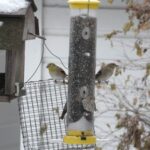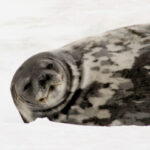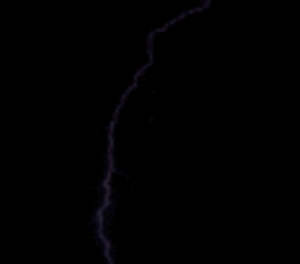Vultures are scavenging birds found on every continent except Australia and Antarctica per wikipedia. They are valued, and feared, as birds that clean up carcasses after death. At times they have been known to kill dying animals. Vultures feast and gorge when kill is available storing it in their crop from which they can reguritate the food for their young. A vulture’s stomach acids are powerfully corrosive allowing them to safely digest rotting and diseased flesh. When threatened they have the ability to projectile their corrosive vomit to ward off unwelcomed creatures and people. They urinate straight down their legs with urine that kills bacteria from walking in rotting carcasses. Vultures are also referred to as buzzards or carrion crows, in error.
Two types of vultures reside in Florida and both are protected by Federal Law. A permit approval is required by the US Fish and Wildlife Service in order to kill one. In Florida it can be hard to believe they are protected as there are so many. The more roadkill, the more vultures appear!
More Common and Larger Florida Turkey Vulture: (Cathartes aura) Non-feathered red heads (adults) which may keep the vulture cleaner when feasting, and perhaps even cooler on hot and steamy days and roadways. About 2 feet tall. About 3-5 pounds. Breathtaking in effortless flight – graceful and soaring with rare flaps of an up to 6-foot wingspan. Black-brown feathers on top with gray feathers under their wings. Featherless legs. Hooked beak tips are white.
When a turkey vulture soars, its legs do not reach its tail. Its wings form a shallow V. Each has keen eyesight during the day and a sense of smell evolved to detect dead prey by the smell of mercaptan which is the gas emitted by rotting flesh. Turkey Vultures will often stand with their wings extended. They have scanty eyelashes on the upper lid and two rows on the bottom lid. They live to be about 16 normally. To my knowledge, the males look like the females, but to the vultures they obviously can tell for mating!
Smaller Florida Black Vulture (Coragyps atratus): A bit less than 2 feet tall, a tad lighter, a narrower wingspan of 54 inches tipped with white feathers on the undersides of their wings, and the rest is a dull black feathering compared to the Turkey Vulture. The Black Vulture sports a wrinkly face and bare black head. Its legs are white-toned and its rounded tail does not cover all of its legs when in flight. They tend to flock while flying. The Black Vulture will readily feast on live prey instead of just dead or dying prey. They have keen eyesight but lack in a strong sense of smell. Though smaller in size than a turkey vulture, the Black Vulture will aggressively keep Turkey Vultures at bay! The lifespan tends to be about 5 years for the Black Vulture.
Habitat: Vultures, who are related to storks, can be found in pastures, marshes, along roads and in landfills – really anywhere they can feed on decaying flesh. The Turkey Vulture smells carrion from a distance and will venture anywhere whereas the Black Vulture tends to return to its past tried-and-true locations or even follow the hunt of Turkey Vultures. They are not known for strength of their legs or for ferocious talons or beaks. Eating fresh kill is easier for them than tearing apart old and tough flesh. Too tough? They may opt to circle (or “buzz” the area) until another creature has broken up the hide or flesh first. I have read that they far prefer animal carcasses of creatures that eat vegetation, instead of carnivores. They see poorly at night so tend to hunt only by daylight.
Problematic Habitat: In co-existing with our populous society they can be menacing or at least a nuisance by pecking on soft objects such as outdoor furniture, gathering for committee roosting, depositing their scat in undesirable places, and feasting on newborns such as inactive calves instead of just eating the afterbirth.
Social Traits: Vultures are very social birds that tend to hunt together and share the kill. They can be seen flying in the same airspace as the carrion below. When they are in company of other vultures, they are referred to as a wake of vultures, or a venue or a committee of vultures. Vultures are built to fly and to stand, but not particularly to pick up prey with their feet – they lack a strong grip. They are not aggressive typically, but can hiss and grunt. That would make me move quickly – just as when a possum growls, I yield!
Mating: They mate for life, as do doves. The Turkey Vulture has a courtship involving several vultures forming a circle with lots of hopping around with wings extended in some type of flapping dance move. When in flight and mating, they fly closely when flapping and diving per http://www.floridiannature.com/vultures.htm. Their young are well hidden as eggs in thickets such as palmettos, hollow logs or trunks, caves, barns, tucked between rocks, and within marshlands, etc. The females lays four or less eggs in February to June (Turkey Vulture) or March to July (Black Vulture). Within 40 days, the eggs hatch and by about 90 days the young are out of the nest. Both parents care for the young.
Depiction: Vultures are easily nature’s casted actors for horror movies due to their foreboding stigma as death watchers. In the past they were oft though of as spiritual messengers, even gods, and symbolized great strength, completely opposite from their horror depiction. To some Native American tribes, the vulture is characterized as having a spirit that cleanses. Carl Hiaasen (I knew his father) has written books wherein the villains are devoured by vultures, as least in part.
I became curious about vultures when I realized there are many here in my hometown area. Nobody seemed to know much except that they are social, have commonalities despite breed, and are the wonderful “garbage trucks” of nature. Having learned so much from this research, I am eager to share my knowledge with all who also wonder! Vultures are now very fascinating birds to me.







